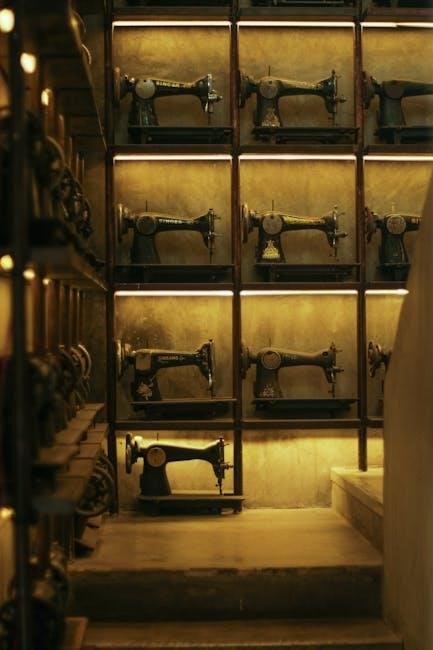
Welcome to the Singer 328K manual, your ultimate guide to understanding and mastering your sewing machine. This comprehensive resource covers setup, operation, maintenance, and troubleshooting, ensuring optimal performance for sewists of all skill levels.
Importance of the Manual
The Singer 328K manual is an essential resource for anyone owning or operating this sewing machine. It provides clear, detailed instructions for setup, operation, and maintenance, ensuring users can unlock the machine’s full potential. Whether you’re a beginner or an experienced sewist, the manual offers troubleshooting tips, maintenance advice, and guidance for mastering advanced techniques. It covers everything from threading and bobbin installation to adjusting tension and timing, helping you achieve professional-quality results. The manual also serves as a valuable reference for understanding the machine’s features and capabilities, making it an indispensable tool for optimal performance and longevity of your Singer 328K sewing machine.
Structure and Content Overview
The Singer 328K manual is organized into clear sections, making it easy to navigate and find specific information. It begins with an introduction to the machine, followed by detailed setup instructions, including unpacking, parts identification, and threading. The manual then delves into operation guides, covering basic and advanced sewing techniques, such as straight stitching, zigzag stitching, and working with various fabrics. Maintenance and troubleshooting sections provide advice on cleaning, lubrication, and resolving common issues. Additional resources include technical specifications, parts lists, and DIY repair tips. The manual concludes with FAQs and tips for optimal performance, ensuring users have a complete understanding of their Singer 328K sewing machine. This structured approach ensures comprehensive coverage of all aspects of the machine, making it an invaluable resource for users of all skill levels.
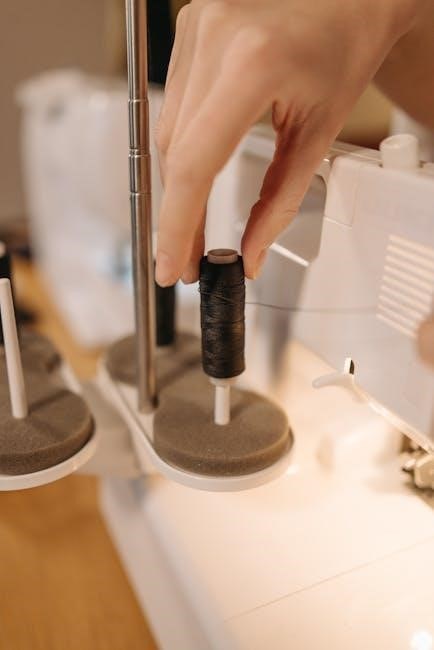
Features and Specifications of the Singer 328K
The Singer 328K boasts automatic needle threading, adjustable stitch length, and a powerful motor for smooth operation. It supports various stitch types, including straight and zigzag, making it ideal for diverse fabrics and projects.
Overview of the Machine
The Singer 328K is a versatile and durable mechanical sewing machine designed for both home and light industrial use. Known for its reliability and ease of operation, it is a popular choice among sewists of all skill levels. This vintage model, manufactured in the 1960s, features a compact design and weighs approximately 22 pounds, making it portable yet sturdy. The machine operates with a class 66 bobbin and supports various stitch types, including straight and zigzag stitching. Its user-friendly interface and robust construction make it ideal for sewing fabrics like cotton, denim, and leather. The Singer 328K is also praised for its quiet operation and consistent stitching, making it a favorite among sewing enthusiasts and collectors alike.
Key Features and Capabilities
The Singer 328K sewing machine is equipped with a range of features that enhance its performance and versatility. It offers both straight and zigzag stitching, making it suitable for various sewing tasks. The machine includes a built-in needle threader, a free arm for easy access to hard-to-reach areas, and an adjustable stitch length and width. It also features a reverse stitch function for securing seams. The 328K supports multiple presser feet, including the standard all-purpose foot and specialized feet for tasks like buttonholes and zipper insertion. Its robust construction ensures consistent stitching, even on heavy fabrics like denim and leather. Additionally, the machine’s manual allows for easy customization of settings to meet individual sewing needs.
Technical Specifications
The Singer 328K sewing machine is a mechanical model designed for versatility and durability. It features a free-arm design for easy access to hard-to-reach areas and a maximum sewing speed of 1,100 stitches per minute. The machine measures approximately 16 inches in length, 7 inches in width, and 12 inches in height, making it compact yet robust. It weighs around 16 pounds, ensuring stability during operation. The 328K is compatible with a variety of fabrics, including cotton, polyester, and denim, and supports both straight and zigzag stitching. The machine operates with a standard 110V power supply and includes a range of accessories like presser feet and a sewing table for enhanced functionality.
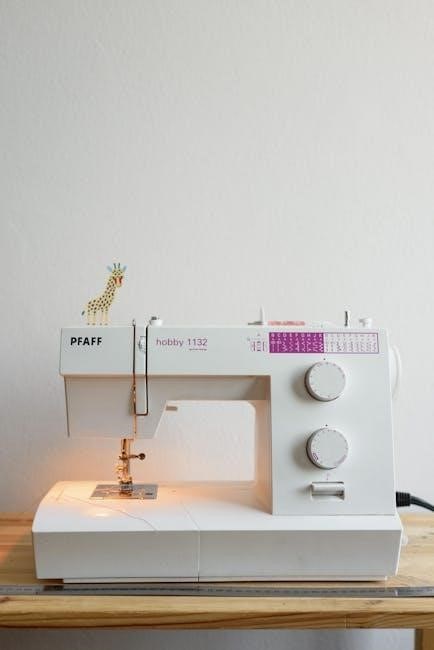
Setting Up the Singer 328K Sewing Machine
Begin by unpacking and inspecting the machine to ensure all parts are included and undamaged. Identify and familiarize yourself with the components, then thread the machine and install the bobbin. Follow the manual’s step-by-step guide for proper setup and basic operation to start sewing seamlessly.
Unpacking and Initial Inspection
When you receive your Singer 328K sewing machine, carefully unpack it from the box and inspect for any visible damage or missing components. Ensure all accessories, such as the foot pedal, power cord, and extra needles, are included. Gently wipe down the machine to remove any packaging residue. Examine the machine’s exterior and internal mechanisms for signs of wear or damage. Refer to the manual’s parts list to verify that all components are accounted for. This initial inspection ensures your machine is ready for setup and operation. If any issues are found, contact the seller or manufacturer promptly for assistance.
Parts and Accessories Identification
The Singer 328K manual includes a detailed parts list to help you identify and understand each component of your sewing machine. Familiarize yourself with the machine’s exterior, including the spool pins, bobbin case, and stitch selectors. Locate essential accessories like the foot pedal, power cord, and various presser feet. The manual also highlights optional attachments, such as zigzag and decorative stitch plates, to enhance functionality. Understanding each part’s purpose ensures proper setup and operation. Refer to the manual’s diagrams for a visual guide to identify and locate all components effectively. This section is crucial for troubleshooting and maintaining your machine’s performance over time.
Threading the Machine
Proper threading is essential for smooth operation of the Singer 328K. Begin by turning off and unplugging the machine. Use high-quality thread suitable for your fabric type. Follow the manual’s threading path, guiding the thread through spool pins, tension discs, and the take-up lever. Gently pull the thread to set tension. After threading, insert the bobbin and pull the end through the bobbin case. Use the handwheel to lower the needle and catch the bobbin thread. Test stitches on scrap fabric to ensure proper tension and alignment. Proper threading ensures consistent quality, prevents issues, and extends machine longevity.
Bobbin Installation and Threading
Installing and threading the bobbin on the Singer 328K is a straightforward process. Start by lifting the presser foot and opening the bobbin compartment. Place the filled bobbin into the case, ensuring it rotates counterclockwise. Thread the end through the small hole and pull it gently until it clicks. Close the compartment and guide the thread to the needle. Use the handwheel to lower the needle, then gently tug to bring up the bobbin thread. Ensure both threads are even and not tangled. Proper installation and threading are crucial for consistent stitching and preventing fabric bunching. Always refer to the manual for precise alignment and tension settings to achieve optimal results. This step ensures smooth sewing and minimizes potential issues.
Basic Machine Operation
Before starting, ensure the Singer 328K is properly set up and plugged in. Turn on the power and lift the presser foot. Use the handwheel to manually raise the needle to its highest position. Place your fabric under the needle, aligning it with the edge guide. Lower the presser foot gently and ensure the fabric is secure. Use the foot pedal to control the sewing speed, starting slowly for precise stitches. Guide the fabric smoothly, keeping it taut but not pulled. For reverse stitching, press the reverse button before sewing forward. Always maintain even thread tension and monitor stitch quality. Keep the work area clear and avoid loose clothing near moving parts. Refer to the manual for specific settings and techniques tailored to your fabric type. This ensures optimal performance and prevents damage.
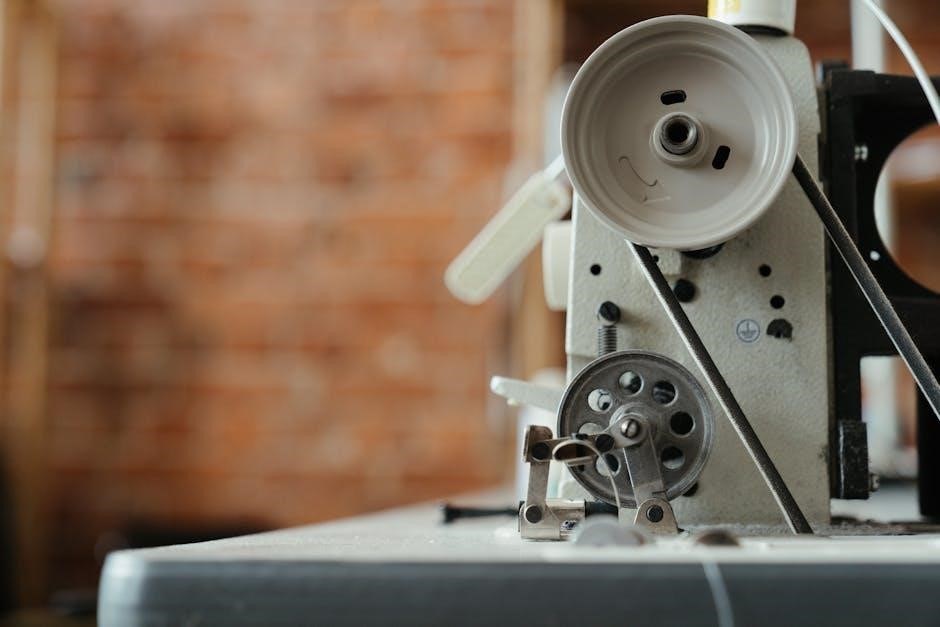
Maintenance and Troubleshooting
Regularly clean and lubricate the Singer 328K to ensure smooth operation. Check for lint buildup and oil moving parts. Address common issues like thread tangling or uneven stitches promptly for optimal performance.
Cleaning and Lubrication
Regular cleaning and lubrication are essential to maintain the Singer 328K’s performance. Use a soft brush to remove lint and debris from the machine’s interior. Wipe exterior surfaces with a clean, dry cloth. Apply a few drops of high-quality sewing machine oil to moving parts, such as the bobbin area and tension discs, to ensure smooth operation. Avoid over-lubrication, as it may attract dust and cause issues. For best results, clean and oil the machine after every project or when you notice sluggish movement. Proper care will extend the life of your Singer 328K and keep it running efficiently for years.
Common Issues and Solutions
Common issues with the Singer 328K include thread bunching, uneven stitching, and mechanical noise. For thread bunching, check thread tension and ensure proper threading. Adjust the bobbin tension if necessary. Uneven stitches may result from incorrect needle size or tension settings; try using the right needle type for your fabric. Mechanical noise could indicate lint buildup or lack of lubrication. Regular cleaning and oiling can resolve this. If problems persist, consult the manual or contact a professional. Addressing these issues promptly will ensure your Singer 328K continues to perform optimally, delivering professional-grade results for all your sewing projects. Regular maintenance is key to minimizing downtime and maintaining quality.
Adjusting Tension and Timing
Proper tension and timing adjustments are crucial for optimal performance of the Singer 328K. To adjust needle thread tension, use 50-weight mercerized thread, lower the presser foot, and turn the thumb nut in the desired direction. For bobbin tension, ensure it’s not too tight or loose, as this can cause uneven stitching; Timing adjustments should be done by a professional, but you can check the hook and needle alignment. Incorrect timing can lead to poor stitch formation. Regularly review the manual for specific guidance, and avoid over-tightening, as this can damage the machine. Proper adjustments ensure smooth operation, consistent stitches, and extend the machine’s lifespan. Always refer to the manual for detailed instructions to maintain your Singer 328K’s performance and reliability.
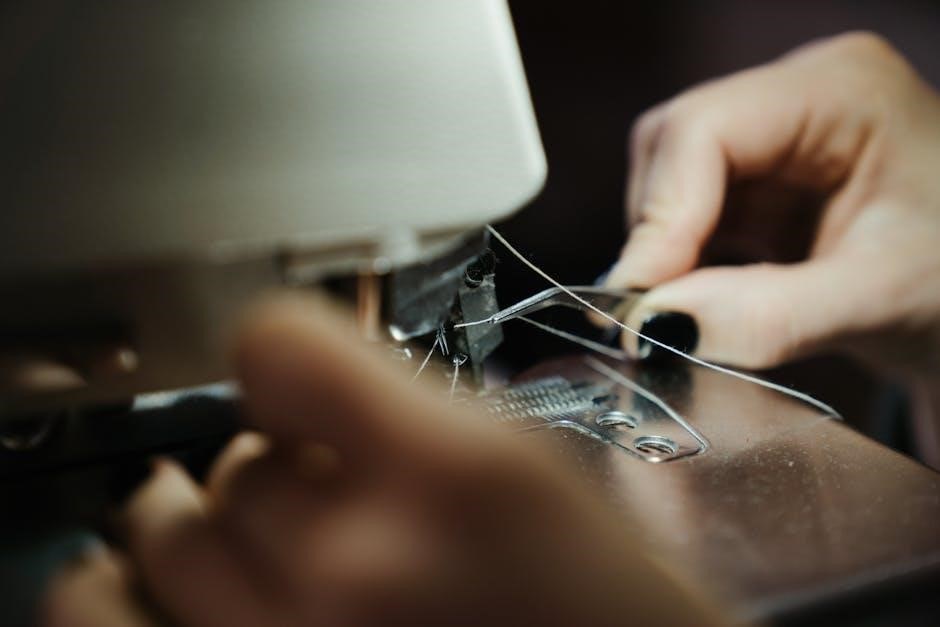
Advanced Sewing Techniques
Master advanced techniques like straight stitching, zigzag patterns, and working with various fabrics. The Singer 328K manual provides detailed guidance for enhancing your sewing skills and creativity.
Mastering Straight Stitch
Mastering the straight stitch is fundamental for any sewing project. The Singer 328K manual guides you through setting the correct stitch length and tension for precise, even stitching. Begin by threading the machine as instructed, ensuring the bobbin is properly installed. Practice on scrap fabric to achieve consistent results. Adjust the stitch length based on fabric type, from delicate fabrics to heavier materials. The manual also provides troubleshooting tips for common issues like uneven stitches or thread tangling. Regular maintenance, such as cleaning and oiling, ensures smooth operation. With practice, you’ll effortlessly create professional-looking straight stitches, forming the foundation for more complex techniques.
Zigzag Stitching and Decorative Stitches
Zigzag stitching and decorative stitches add versatility to your sewing projects. The Singer 328K manual provides clear instructions for selecting and adjusting these stitches. Use the zigzag stitch for finishing seams, preventing fraying, and creating decorative edges. Decorative stitches, such as the blind hem and stretch stitches, are ideal for embellishments and specialized fabrics. The manual guides you in adjusting stitch width, length, and tension for optimal results; Practice on scrap fabric to master these techniques, ensuring smooth, even stitching. Troubleshooting tips for thread tension and stitch alignment are also included, helping you achieve professional-looking results for both functional and creative projects.
Working with Different Fabrics
The Singer 328K manual offers detailed guidance on sewing with various fabrics, ensuring optimal results. Learn how to adjust stitch settings for lightweight materials like silk and heavier fabrics like denim. The manual provides tips for handling delicate fabrics, preventing bunching, and maintaining even tension. Discover the best presser feet for different materials and how to use the machine’s built-in features for smooth fabric handling. Troubleshooting sections address common issues, such as thread breakage or uneven stitching, helping you achieve professional-looking results. Whether working with cotton, linen, or stretch fabrics, the manual empowers you to tackle any project with confidence and precision.
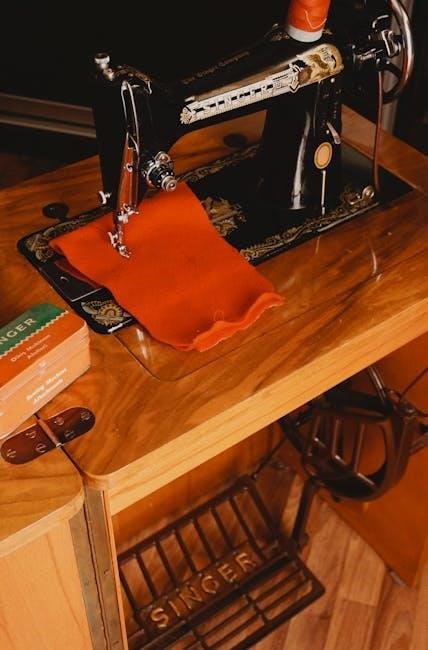
Accessories and Attachments
The Singer 328K manual highlights essential accessories like presser feet (zigzag, buttonhole, zipper) and optional attachments for specialized tasks, enhancing your sewing experience and machine versatility.
Presser Feet and Their Uses
Presser feet are essential accessories for the Singer 328K sewing machine, designed to enhance versatility and precision in various sewing tasks. The standard all-purpose foot is ideal for straight stitching and general sewing. The zigzag foot is perfect for decorative stitching and zigzag patterns, while the zipper foot allows for precise stitching close to zippers or thick seams. Additional feet, such as the buttonhole foot, enable automatic buttonhole creation with consistent results. Each presser foot is designed to improve stitch quality, reduce fabric slippage, and make sewing easier. By using the right foot for the job, users can achieve professional-looking results and expand their creative possibilities. Always refer to the manual for proper installation and usage tips.
Optional Attachments for Enhanced Functionality
The Singer 328K sewing machine can be enhanced with optional attachments to expand its capabilities. The buttonhole attachment allows for precise, automatic buttonhole creation, while the ruffler attachment gathers fabric evenly for decorative effects. A quilting guide helps maintain consistent seam allowances, and a walking foot is ideal for heavy or layered fabrics. Additional attachments, such as a zipper foot or a blind hem foot, cater to specific sewing tasks. These accessories enhance versatility, enabling users to tackle a wider range of projects with ease and precision. By investing in these optional attachments, sewists can unlock new creative possibilities and improve their overall sewing experience with the Singer 328K.
Downloading and Accessing the Manual
The Singer 328K manual is readily available for download as a PDF from Singer’s official website, ManualsLib, and other reputable online archives, ensuring easy access for users.
Online Resources and PDF Downloads
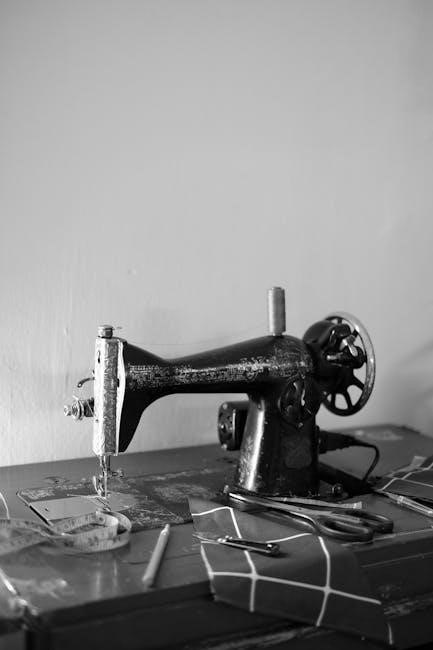
The Singer 328K manual is widely available online, offering convenient access to users. Reputable platforms like ManualsLib, Singer’s official website, and Internet Archive provide downloadable PDF versions. These resources ensure that users can easily access detailed instructions, troubleshooting guides, and maintenance tips. Additionally, websites like eBay and specialized sewing forums often host digital copies of the manual, catering to both vintage and modern sewing enthusiasts. With multiple sources available, users can download the manual effortlessly, ensuring they have all the information needed to operate and maintain their Singer 328K sewing machine effectively. This accessibility makes it simple for users to unlock their machine’s full potential.
Archives and Vintage Manual Sources
Vintage enthusiasts and collectors can find the Singer 328K manual in various archives and specialized repositories. Platforms like Internet Archive and ManualsLib host scanned versions of original manuals, preserving their historical value. Additionally, eBay and Etsy often feature vintage Singer 328K manuals as collectible items, perfect for those seeking authentic documentation. These sources cater to users who appreciate the nostalgic appeal of physical copies or require precise historical instructions. By exploring these archives, users can access rare and original content, ensuring their Singer 328K operates as intended, even decades after its release. This makes it a valuable resource for both practical use and historical reference.
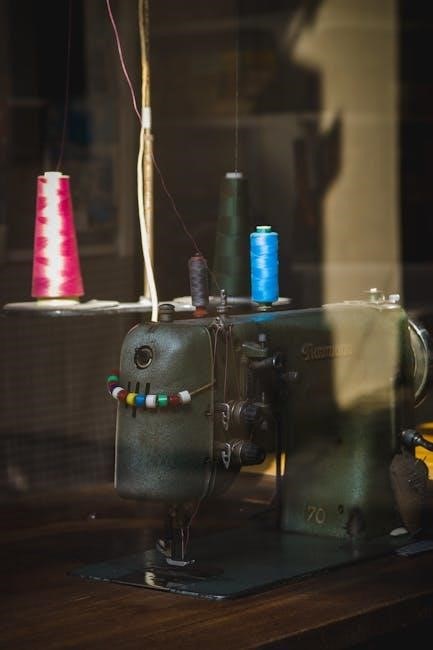
Model-Specific Information
The Singer 328K is part of a series known for its durability and stitch quality, offering unique features that distinguish it from other models in the lineup.
Differences Between 327K and 328K Models
The Singer 327K and 328K models share similarities but have distinct features. The 327K is known for its simplicity and reliability, catering to basic sewing needs, while the 328K offers advanced capabilities, including automatic tension and additional stitch options. Both models are durable and popular among sewists, but the 328K is preferred for its versatility in handling various fabrics and decorative stitching. The 327K is ideal for beginners, whereas the 328K suits experienced users seeking more control. Understanding these differences helps users choose the right model for their sewing projects. Detailed specifications and comparisons can be found in the manual or online resources.
Compatible Parts and Accessories
The Singer 328K sewing machine is supported by a wide range of compatible parts and accessories, ensuring optimal performance and versatility. Key components include presser feet for various stitching techniques, additional bobbins, and high-quality needles designed for different fabrics. Optional attachments, such as zipper feet and quilting guides, enhance functionality for specialized tasks. Genuine Singer parts are recommended to maintain machine performance and longevity. Users can find these items through Singer’s official website, sewing supply stores, or online marketplaces. The manual and service guides provide detailed lists of compatible parts, making it easy to identify and source what you need. This ensures your Singer 328K remains a reliable companion for all your sewing projects.
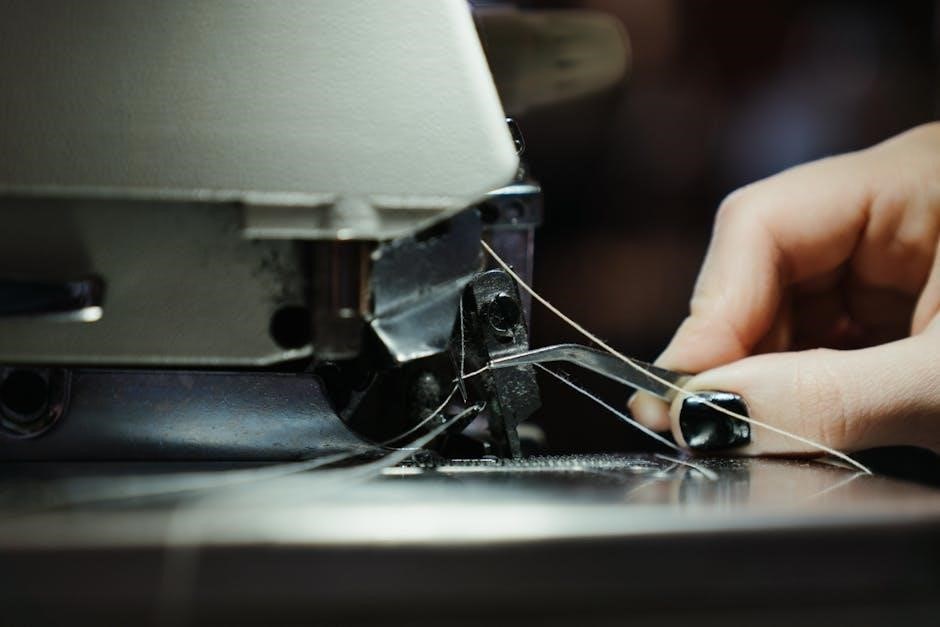
Service and Repair
The Singer 328K requires regular servicing to ensure optimal performance. Service manuals offer detailed repair guides and DIY tips, helping users maintain and troubleshoot their machine effectively.
Professional Servicing Recommendations
Regular professional servicing is essential to maintain the Singer 328K’s performance and longevity. Certified technicians can address complex issues, ensuring proper alignment, tension, and timing. Schedule annual check-ups to prevent mechanical failures and extend the machine’s lifespan. Use genuine Singer parts for repairs to avoid compatibility issues. Refer to the service manual for guidance on finding authorized service centers. Professional servicing ensures your machine operates smoothly, preserving its quality and reliability over time. DIY repairs are possible but may void warranties or cause further damage if not done correctly. Trust professionals for intricate adjustments and thorough maintenance to keep your Singer 328K in optimal condition.
DIY Repair Tips and Guidelines
For minor issues with your Singer 328K, DIY repairs can save time and money; Always consult the manual before attempting any fixes to ensure safety and correctness. Common tasks include adjusting thread tension, cleaning lint buildup, and lubricating moving parts. Replace worn-out needles and bobbin cases regularly to prevent stitching problems. Avoid complex repairs like motor adjustments, as these require professional expertise. Use only Singer-approved parts to maintain compatibility and performance. Follow step-by-step instructions in the manual for tasks like reinstalling the bobbin or adjusting stitch length. DIY repairs can extend your machine’s life but be cautious not to overcomplicate repairs, as this may cause further damage.
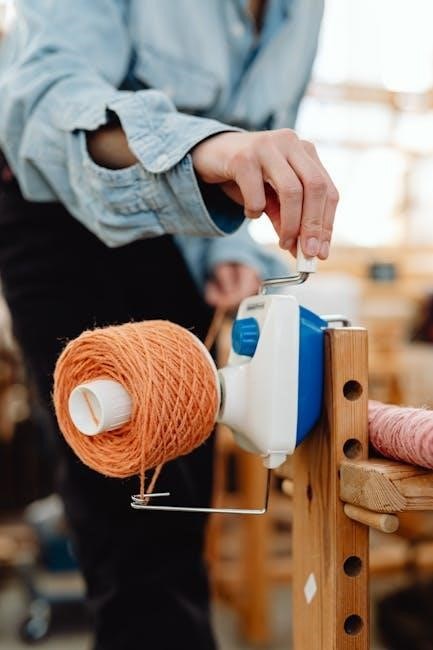
Frequently Asked Questions
The Singer 328K manual addresses common queries about threading, bobbin installation, tension adjustment, and maintenance, providing clear solutions for setup, operation, and troubleshooting.
Common Queries and Answers
Users often ask about threading techniques, bobbin installation, and tension adjustment for the Singer 328K. Another common query is how to resolve thread tangling or uneven stitching. Many seek guidance on maintaining the machine, including cleaning and lubrication. Additionally, questions about compatibility with vintage parts and accessories frequently arise. Some users inquire about troubleshooting common issues like needle breakage or motor noise. The manual also addresses queries regarding the use of different fabric types and decorative stitching options. Overall, the Singer 328K manual provides clear answers to these frequently asked questions, ensuring smooth operation and optimal performance for sewists of all levels.
Tips for Optimal Performance
To ensure your Singer 328K performs at its best, always use high-quality threads and needles suitable for your fabric type. Regularly clean and lubricate the machine to prevent dust buildup and friction. Properly tension the needle and bobbin threads to avoid uneven stitching. For delicate fabrics, use a lighter touch on the pedal, while heavier fabrics may require a steady, consistent speed. Store the machine in a dry, cool place to protect it from moisture and damage. By following these tips, you can extend the life of your Singer 328K and achieve professional-grade results in your sewing projects.